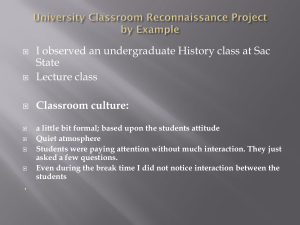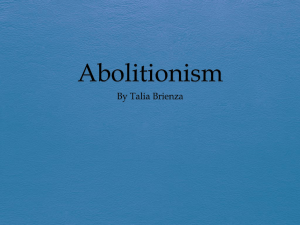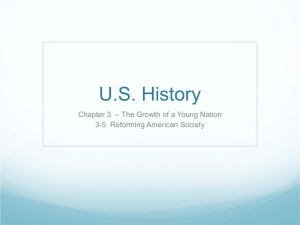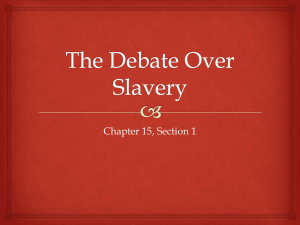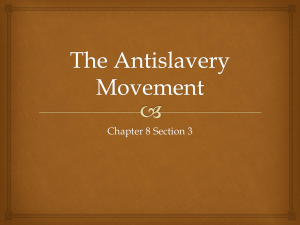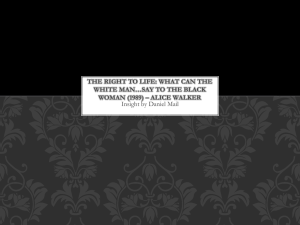Understanding Abolitionism
advertisement
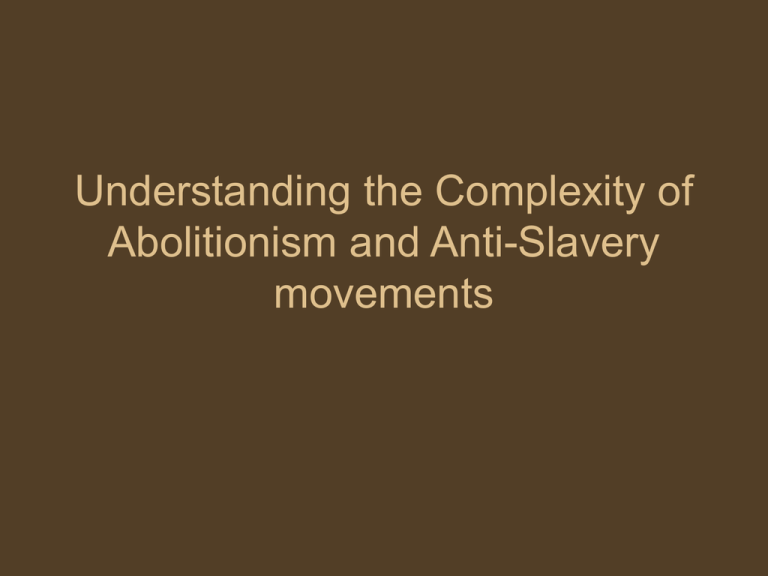
Understanding the Complexity of Abolitionism and Anti-Slavery movements Paradox: • Being Anti-Slavery did not necessarily make you a friend of the Slave. • Americans opposed slavery for various reasons and used various methods in their opposition. Southerners Lamenting Slavery • In the early republic, even southerners questioned the future and morality of slavery (Like Washington) • Ideology of the revolution • Evangelical influence (Second Great Awakening) – blunted by 1820 • Southern abolitionism dies out about 1830-1832. Virginia assembly meets to discuss prospect / Nat Turner’s rebellion. Abolition the Political Issue • North vs. South in struggle for political mastery • “Political Abolitionism” – not so much opposed to slavery on moral grounds, but that the slave state voting bloc and 3/5’s Compromise puts South in driver’s seat. • Focused on stopping the spread of slavery. • Like “red state/blue state politics” Abolition Politics as a Labor Issue • By 1840s, “Free Soil” movement emerges • White laboring classes (farmers, mechanics) who want to stop the spread of slavery • They don’t want to compete with unfree labor. • They don’t care about slavery where it already exists The political threat posed by containing slavery • The South feared abolition movements that threatened to stop the spread of slavery because such movements would inhibit the South’s ability to maintain a political parity with the North • In time, the South would become a political minority, and as such, subject to the whim of Northern will. • For the South to defend slavery politically, it HAD to expand. The economic threat of containing slavery • Stopping slavery’s expansion eliminated (in theory) the market for future generations of slaves Abolition the Moral Issue • By far the most threatening because it challenges the persistence of slavery where it exists. • Far less common than “political abolitionism” Early Moral Abolition: Gradualism • Abolition within the conventions of a racist culture: Inability to see slaves as Americans. • Emphasis on resettlement, deportation • American Colonization Society • Liberia, “Monrovia” • Respect for southern property rights • Sensitive to racial attitudes of white Americans, North and South • Sensitive to preserving racial hierarchy Intellectual Changes in the North: “Perfectionism” • Transcendentalism and other “perfectionist” ideals take root, particularly in New England 1820s – 1830s • Belief in reform and “perfectability of mankind” • Temperance, anti-prostitution, and antislavery • Involvement of women in moral crusade Moral Abolition: Immediatism • • • • The rise of William Lloyd Garrison Starts Liberator in 1831 Calls for the immediate end to slavery Not only is slavery wrong, but slaveholders are immoral. • Enrages slaveholders • Enrages a lot of northerners too • A minority view for many years William Lloyd Garrison Garrison and Southern Conceptions of Honor • Garrison made abolitionism a personal attack upon the honor of southerners by charging them with a unconscionable crime. • Undermines southern claims to honor and patriarchy • Immediatist abolition movement small but vocal. • Hardens defenses of slavery. • Encourages the development of pro-slavery rhetoric from southern intellectuals and clergy. Women and Moral Abolitionism • As part of the antebellum period’s move toward moral improvement, women become involved in abolitionism. • Religious overtones • The fictional “Uncle Tom” character • The imperiling of white morality Northern Women • Harriett Beecher Stowe and Uncle Tom’s Cabin • Representative of white northern women from elite backgrounds who take up the cause of abolition. • Both moral and emotional suasion Southern White Women • The Grimke Sisters of South Carolina • Become sought-after speakers • Credibility as beneficiaries of slave system • Focus: Slavery’s damage to white morality The Slave Narrative • Harriett Jacobs and Incidents in the Life of a Slave Girl • Shocking forcefulness • Narrative of sexual exploitation Jacobs’ hiding place Imagery and Abolitionism Some images did not need to be fabricated: Here an actual advertisement for the sale of slaves strikes most normal modern observers as inherently sinister. Imagery and Auctions Imagery and the limits of white compassion: “tragic mulattas” Photograph of “nearly white” slave girl “auctioned” by Henry Ward Beecher to raise funds for abolitionist causes in Boston
